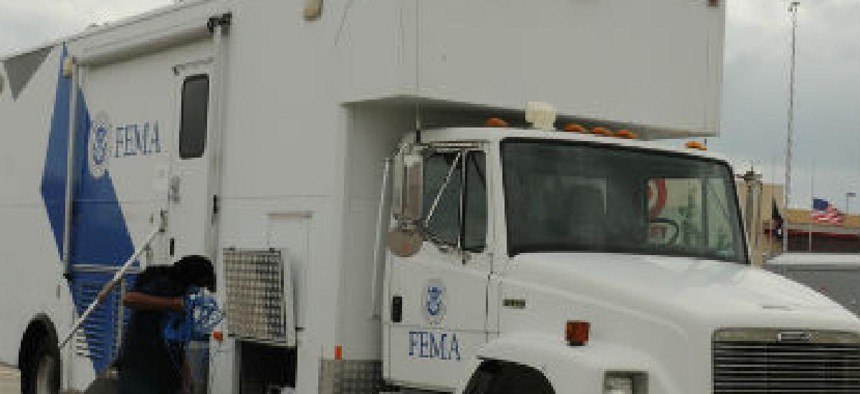FEMA mobile comms units roll in for Harvey

The federal disaster agency's fleet of mobile offices is helping power communications support for emergency responders in the Texas flood.

A FEMA emergency communications rig, like the kind deployed to Texas to support first responders coping with Hurricane Harvey.
The Federal Emergency Management Agency has sent almost a dozen mobile communications vehicles in its response to Hurricane Harvey's assault on the Texas coast.
The vehicles are part of FEMA's Mobile Emergency Response Support (MERS), which provides mobile telecommunications, life support, logistics, operational support and power generation for the on-site management of disaster response activities.
The self-contained Mobile Emergency Operations Vehicles are equipped with power generation and satellite communications capabilities that are initially deployed to provide mobile office support, including videoconferencing, at locations that lack infrastructure.
In an Aug. 28 statement, FEMA said 65 MERS employees were in Texas.
The emergency response operations include help with coordinating the physical distribution of supplies; administrative support for federal, state and local first responders; truck-mounted generators; and heating, ventilation and air conditioning units.
According to FEMA, the units vary in size and provide support and location for a command post, initial operating facility or joint field office.
The flooding disaster unfolding in Houston and along the Gulf Coast is the kind of massive event that the planned FirstNet nationwide interoperable wireless network for first responders could help address.
However, even when FirstNet is fully deployed, it will not supplant the survivable, mobile capabilities that FEMA brings, said Ken Rehbehn, principal analyst at Critical Communications Insights.
"No network infrastructure is completely survivable," he said, adding that the communications networks in the stricken area have been remarkably resilient -- "a lesson from [Superstorm] Sandy," which taught telecom carriers to more fully protect their networks from flooding.
According to the Federal Communications Commission, the heaviest damage to wireless carrier infrastructure has been concentrated in the bull's-eye for the strongest winds where Hurricane Harvey first made landfall. According to an Aug. 27 FCC report, 4.1 percent of cellular communication sites were down in the 55 counties stretching along the Gulf Coast from the easternmost tip of Louisiana to the southernmost tip of Texas.
Rehbehn said that once FirstNet is fully deployed, the Department of Homeland Security and FEMA will take advantage of the network in disaster zones. However, he added that they will not be able to rely on FirstNet for service in every situation. Satellite capabilities are important in recently stricken areas or remote areas without immediate access to infrastructure, he said.
AT&T was contracted to construct FirstNet's interoperable LTE-based wireless network. Rehbehn said the company is also putting together mobile communications vehicles, such as "satellite-on-wheels" and "cells-on-wheels," but in a big disaster such as Hurricane Harvey, there are never enough to go around.
Sixteen states have opted into FirstNet's plans. Texas officials, however, have not decided yet.
Harris County, which includes hard-hit Houston, was an early adopter of the Band 14 LTE capabilities FirstNet will harness.
Houston-area first responders used the technology during Super Bowl LI at NRG Stadium in February. A report on the test, issued in June, said it was "the first large‐scale special event to incorporate the use of mobile apps to support public safety communications from the very beginning of the planning process as key operational tools."
Almost 1,000 public safety personnel from 10 state, federal and local agencies were trained to use the technology, according to the report.





